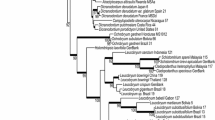Abstract
Chemical data are given forSciadophyton, Eogaspesiea,Lepidodendropsis, Triphyllopteris, Chlidanophyton andDrepanophycus. The participation of these taxa within clustering analysis is shown to generate a cluster referable tentatively to the lycopods. Introgression of clusters representative of some major plant groups (e.g., zosterophyllophytes with the lycopods, and the trimerophytes with the progymnosperms) may reflect fortuitous statistical relationships referable to different states of preservation orbona fide phylogenetic trends. Weighting of the data is shown to result in the greater resolution of clusters, while sample size (presently 34 taxa) demonstrates a considerable effect on statistical relationships. Thermolytic alterations of extant plant materials, when incorporated within fossil plant ordination diagrams, are shown to provide internal monitors allowing for a more precise evaluation of taxonomic-chemical relationships.
Similar content being viewed by others
Literature Cited
Ball, G. H. 1971. Classification analysis. Stamford Research Institute, SRI Project 5533: 1–53.
Banks, H. P. 1968. The stratigraphic occurrence of early land plants and its bearing on their origin, pp. 721–730.In: D. H. Oswald (Editor), International Symposium on the Devonian System, Vol. I. Alberta Soc. Petroleum Geologists, Calgary, Canada.
Birks, H. J. B., T. Webb III, & A. A. Berti. 1975. Numerical analysis of pollen samples from central Canada: A comparison of methods. Rev. Palaeobot. Palynol. 20: 133–170.
Brown, A. C., B. A. Knights, & E. Conway. 1969. Hydrocarbon content and its relationship to physiological state in the green algaBotryococcus braunii. Phytochemistry 8: 543–547.
Cattell, R. B. & M. A. Coulter. 1966. Principles of behavioural taxonomy and the mathematical basis of the taxonome computer program. Br. J. Math. Statist. Psychol. 19: 237–269.
Chittenden, G. J. F. & A. W. Schwartz. 1976. Possible pathway for prebiotic uracil synthesis by photodehydration. Nature 263: 350–351.
Daber, R. 1960.Eogaspesiea gracilis n. g. n. sp. Geologie 4: 418–425.
Dembicki, H., W. G. Meinschein, & D. E. Hattin. 1976. Possible ecological and environmental significance of the predominance of even-carbon number C20-C30 n-alkanes. Geochim. Cosmochim. Acta 40: 203–208.
Dolph, G. E. 1975. A statistical analysis ofApocynophyllum mississippiensis. Palaeontographica, Abt. B. 151: 1–51.
Dungworth, G. 1976. Optical configuration and the racemisation of amino acids in sediments and in fossils—a review. Chemical Geology 17: 135–153.
Gray, J. & A. J. Boucot. 1977. Early vascular land plants: Proof and Conjecture. Lethaia 10: 145–174.
Gensel, P. G. 1973. A new plant from the lower Mississippian of South West Virginia. Palaeotographica, Abt. B. 142: 137–153.
Good, B. H. & R. L. Chapman. 1978. The ultrastructure ofPhycopeltis (Chroolepidaceae ; Chlorophyta). I. Sporopollenin in the cell walls. Amer. J. Bot. 65: 27–33.
Gordon, A. D. & I. C. Prentice. 1977. Numerical methods in Quaternary paleoecology. IV. Separating mixtures of morphologically similar pollen taxa. Rev. Palaeobot. Palynol. 23: 359–372.
Hohn, M. E. & W. G. Meinschein. 1977. Fatty acids in fossil fruits. Geochim. Cosmochim. Acta 41: 189–193.
Ikan, R., M. J. Baedecker, & I. R. Kaplan. 1975. Thermal alteration experiments on organic matter in recent marine sediments—III. Aliphatic and steroidal alcohols. Geochim. Cosmochim. Acta 39: 195–203.
KrÄusel, R. & H. Weyland. 1930. Die Flora des deutschen Unterdevons. Abh. preuss. geol. Landesanst., N. F. 131: 1–92.
Matsuda, H. & T. Koyama. 1977. Early diagenesis of fatty acids in lacustrine sediments—1. Identification and distribution of fatty acids in recent sediments from a freshwater lake. Geochim. Cosmochim. Acta 41: 777–783.
Morrison, D. G. 1967. Measurement problems in cluster analysis. Management Science 13: 775–780.
Niklas, K. J. 1976a. Chemical examinations of some non-vascular Paleozoic plants. Brittonia 28: 113–137.
— 1976b. Organic chemistry ofProtosalvinia (=Forestia) from the Chattanooga and New Albany Shales. Rev. Palaeobot. Palynol. 22: 265–279.
— & W. G. Chaloner. 1976a. Chemotaxonomy of some problematic Paleozoic plant fossils. Rev. Palaeobot. Palynol. 22: 81–104.
—. 1976b. Simulations of the ontogeny ofSpongiophyton, a Devonian plant. Ann. Bot. 40: 1–11.
— & P. G. Gensel. 1976. Chemotaxonomy of some Paleozoic vascular plants. Part I: Chemical compositions and preliminary cluster analyses. Brittonia 28: 353–378.
—. 1977. Chemotaxonomy of some Paleozoic vascular plants. Part II: Chemical characterization of major plant groups. Brittonia 29: 100–111.
— & D. E. Giannasi. 1977. Geochemistry and thermolysis of flavonoids. Science 197: 767–769.
Read, C. B. 1955. Floras of the Pocono Formation and Price Sandstone in parts of Pennsylvania, Maryland, West Virginia and Virginia. Geol. Survey, Prof. Paper No. 263: 1–32.
Schwartz, A. W., M. Van der Veen, M. Bisseling, & G. J. F. Chittenden. 1975. Prebiotic nucleotide synthesis—demonstration of a geochemically plausible pathway. Origins of Life 6: 163–168.
Sneath, P. H. & R. R. Sokal. 1973.Numerical Taxonomy. Freeman, San Francisco.
Teil, H. & J. L. Cheminee. 1975. Application of correspondence factor analysis to the study of major and trace elements in the Erta Ale Chain (Afar, Ethiopia). Math. Geol. 7: 13.
Wallace, C. S. & D. M. Boulton. 1968. An information measure for classification. Computer J. 11: 185–198.
Wehmiller, J. F., P. E. Hare, & G. A. Kujala. 1976. Amino acids in fossil corals: racemization (epimerization) reactions and their implementations for diagenetic models and geochronological studies. Geochim. Cosmochim. Acta 40: 763–776.
Williams, W. T. & M. B. Dale. 1965. Fundamental problems in Numerical taxonomy. pp. 134–162.In: R. D. Preston (Editor), Advances in Botanical Research, Vol. 2. Academic Press, London.
Author information
Authors and Affiliations
Rights and permissions
About this article
Cite this article
Niklas, K.J., Gensel, P.G. Chemotaxonomy of some Paleozoic vascular plants. Part III. Cluster configurations and their bearing on taxonomic relationships. Brittonia 30, 216–232 (1978). https://doi.org/10.2307/2806656
Issue Date:
DOI: https://doi.org/10.2307/2806656




